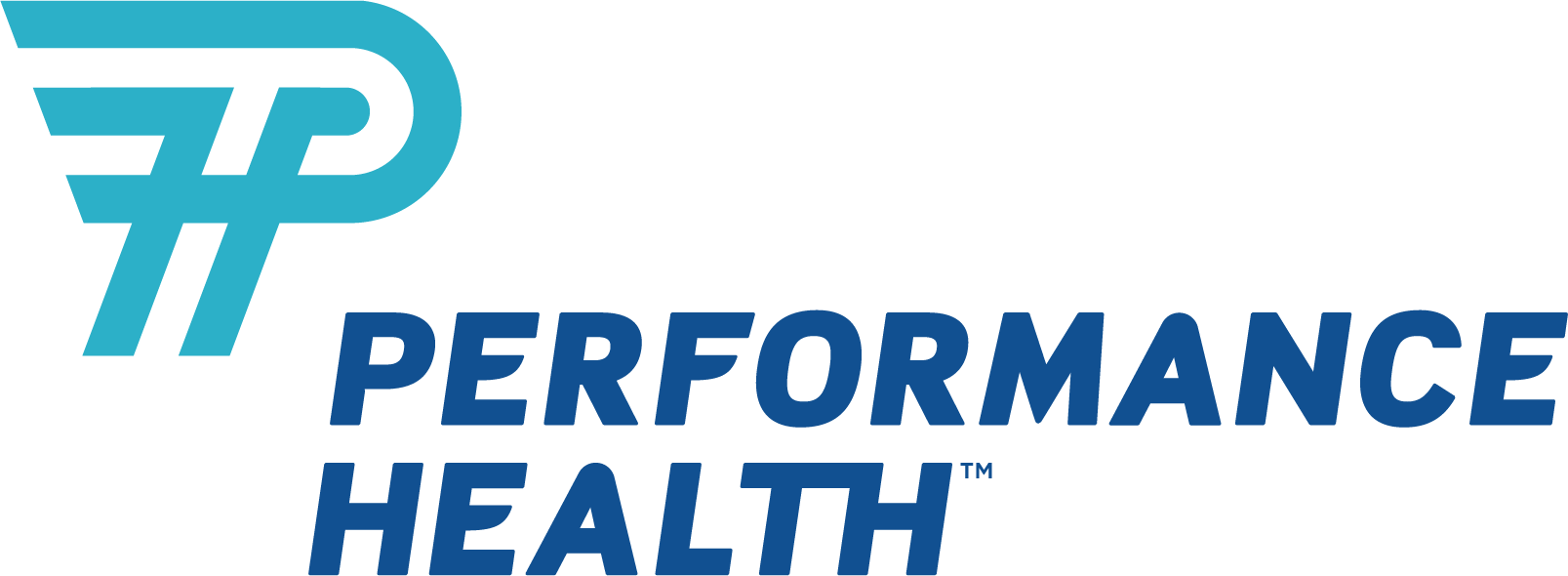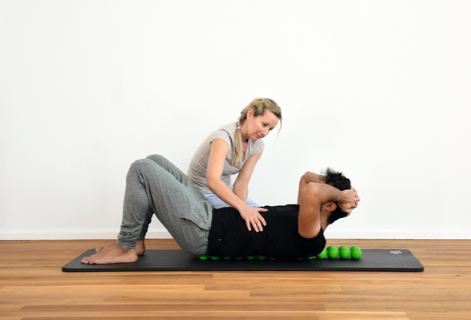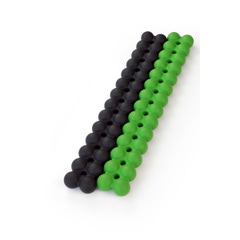SPINEFITTER, a novel therapeutic instrument developed by Sissel, is transforming the fields of spinal rehabilitation. Its innovative design integrates the principles of myofascial release, joint mobilization, and proprioceptive training, offering a versatile and effective tool for physical therapists. This article will explore the mechanics of SPINEFITTER, its applications in physical therapy and will provide illustrative examples to demonstrate its effectiveness.
Comprehending SPINEFITTER's Mechanisms
Featuring a meticulously organized system of 28 strategically positioned spheres, SPINEFITTER's innovative design is arranged in two parallel rows. This configuration is not only visually appealing but also carefully engineered to reflect the complex and nuanced paraspinal anatomy of the human spine. This thorough introspection enables a therapeutic intervention that is both highly effective and precisely targeted, addressing the underlying causes of various musculoskeletal issues rather than merely the superficial aspects. We should explore the multifaceted mechanisms that are in operation:
1. Targeted Myofascial Release: The focused pressure applied by the individual spheres serves as a method of myofascial release. SPINEFITTER's precise pressure, unlike broader pressure techniques such as foam rolling, targets specific areas of myofascial restriction, effectively addressing localized tension and adhesions. This precision is especially beneficial for individuals experiencing chronic pain, as widespread fascial restrictions often lead to discomfort and limited mobility. The targeted nature of the pressure promotes a more effective release of tension within the deep paraspinal muscles, helping to alleviate trigger points and restore the tissue's normal pliability.
2. Enhanced Joint Mobilization: The arrangement of the spheres encourages subtle yet significant movement within the facet joints of the spine. Normative joint mechanics are restored through this moderate mobilization, which operates similarly to manual therapy techniques. However, SPINEFITTER enables self-administered joint mobilization, thus promoting the restoration of natural spinal mobility, unlike manual therapy, which is labor-intensive and requires hands-on attention from a trained professional. SPINEFITTER aids in alleviating pain and improving functional movement patterns by reducing joint stiffness and enhancing the range of motion.
3. Enhanced Proprioceptive Feedback: SPINEFITTER's built-in instability activates the body's proprioceptive system, a complex network of sensory receptors that provide constant feedback on body position and movement. Users consistently face the challenge of maintaining balance while using the device, requiring elevated neuromuscular control. This ongoing feedback loop strengthens the connection between the brain and the body, contributing to improvements in several key areas:
- Enhanced Body Awareness: Users gain a greater awareness of the subtle changes in their body's position, which in turn enhances postural control and reduces the risk of injury.
- Enhanced Balance and Coordination: SPINEFITTER's balance challenges improve coordination and overall stability, leading to better performance in athletic activities and daily tasks.
- Enhanced Neuromuscular Efficiency: The ongoing need for adjustments and corrections reinforces neuromuscular pathways, lowering the risk of muscle imbalances and boosting efficiency.
4. SPINEFITTER's design is ergonomic and promotes natural spinal alignment. The curvature of the device gradually guides the spine into a more neutral position, reducing the strain associated with poor posture and encouraging proper spinal mechanics. This passive correction of postural deviations can significantly relieve pain and enhance the effectiveness of other therapeutic interventions.
5. Adaptable Pressure and Intensity: SPINEFITTER's spheres are firm and deliver consistent pressure, while their material allows for some flexibility to adjust to the individual's body shape and pressure tolerance. This adjustability facilitates the customization of treatment intensity, accommodating a wide range of mobility and palevels.
In essence, it is not merely a collection of balls; it is a meticulously designed therapeutic instrument that utilizes the body's natural mechanisms to effectively address musculoskeletal imbalances, improve mobility, enhance stability, and promote overall wellness.
Therapeutic Applications
SPINEFITTER's applications are highly adaptable and extend to physical rehabilitation settings. It is essential for treating a diverse range of musculoskeletal conditions due to its ability to target specific therapeutic goals:
- SPINEFITTER Management of Low Back Pain: SPINEFITTER is crucial for effectively managing low back pain, as it addresses myofascial restrictions, improves spinal mobility, and strengthens abdominal muscles. The therapist supervises customized exercises that focus on gentle spinal movements to alleviate discomfort and enhance functional movement.
- Neck Pain and Tension Relief: SPINEFITTER reduces neck pain and stiffness by gently mobilizing the cervical spine and relieving tension in the neck muscles. It provides a comprehensive approach to managing neck discomfort, especially when combined with manual therapy techniques such as myofascial release.
- Shoulder Rehabilitation: SPINEFITTER is beneficial for treating conditions like adhesive capsulitis and rotator cuff injuries, as it improves scapular stability and shoulder mobility. Exercises designed to enhance scapulohumeral rhythm and relieve shoulder discomfort are advantageous.
- Postural Correction and Stability Enhancement: SPINEFITTER improves proprioception and strengthens core muscles to enhance postural alignment and increase body awareness. Balance-challenging exercises boost neuromuscular control and reduce the risk of falls.
SPINEFITTER is an important tool in the rehabilitation of patients recovering from spine surgery due to its ability to gently mobilize the spine without excessive stress. This applies to both pre- and post-surgical rehabilitation.
Clinical Case Study: Rehabilitation of a Patient with a Disc Herniation
I have recently extensively employed SPINEFITTER with a patient. A 45-year-old male patient presented with a lumbar disc herniation, resulting in severe low back discomfort that radiated down his right leg. Throughout his rehabilitation, I employed SPINEFITTER.
Phase 1: Postural Work and Pain Management:
- Modalities: The patient's response and preferences were used to determine the appropriate use of dry needling, laser therapy, and NSAIDs to manage pain and inflammation.
- Rest and Activity Modification: The patient was advised to prioritize rest and refrain from engaging in activities that exacerbated his discomfort.
- SPINEFITTER for Myofascial Release: The patient was directed to lie supine on SPINEFITTER for 15 minutes, two to three times per day. The emphasis was placed on diaphragmatic breathing during this period in order to facilitate passive myofascial release by reducing muscle spasms and promoting relaxation.
- Basic stretches that target the hamstrings and hip flexors were introduced, and they were executed off SPINEFITTER to enhance flexibility and address potential contributing factors to the patient's discomfort. Gentle stretching was introduced.
Phase 2: Core Strengthening and Joint Mobilization:
This phase was dedicated to the improvement of spinal stability, core strength, and mobility.
- SPINEFITTER for Joint Mobilization: SPINEFITTER was employed to introduce gentle spinal flexion, extension, and rotation exercises. The patient's response was closely monitored by the therapist, who ensured that the movements were pain-free. Based on the patient's tolerance, the intensity and number of repetitions were progressively increased.
- Core Strengthening: Exercises that target the core, including pelvic tilts and abdominal bracing, were implemented both on and off SPINEFITTER. These exercises were designed to promote spinal mobility and expand the chest by promoting thoracic breathing.
- Pain Management: Pain medication and modalities were maintained as required.
Phase 3: Functional Movement Training:
The final phase transitioned to functional movement training:
- Advanced SPINEFITTER Exercises: To further enhance core stability, vertebral control, and balance, SPINEFITTER included more challenging exercises, such as modified planks and bird-dog variations. The therapist consistently monitored the patient's form to ensure that the correct technique was being used.
- Functional Exercises: Functional exercises mimicking daily activities, such as lifting and twisting, were gradually introduced, provided they were done with proper form and within pain tolerance limits. These exercises took place on and off SPINEFITTER. Segmental respiration techniques were implemented to improve localized muscle activation and control during challenging movements.
- Postural Education: The patient received thorough instruction on the importance of maintaining proper posture throughout the day to relieve strain on the spine and prevent symptom recurrence.
Result:
The patient experienced a significant reduction in pain, improved range of motion, increased functional capacity, and enhanced core strength and stability. He reported a noteworthy increase in his ability to perform daily activities with minimal discomfort. At the end of his rehabilitation, he smoothly transitioned to a low back fitness program to further enhance his load tolerance, focusing on maintaining his posture, stability, and strength to prevent future complications.
Conclusion
In summary, SPINEFITTER's numerous applications in physical therapy settings offer significant advantages. It provides a comprehensive approach to spinal and musculoskeletal health by effectively addressing myofascial restrictions, improving joint mobility, and enhancing proprioception. It is important to remember that the use of this device should always be conducted under the supervision of a qualified professional to ensure its safe and effective integration into a personalized treatment plan.
Shop the SPINEFITTER Now:
Medical Disclaimer: The information provided on this site, including text, graphics, images, and other material are for informational purposes only and are not intended to substitute for professional medical advice, diagnosis, or treatment. Always seek the advice of your physician or other healthcare professional with any questions or concerns you may have regarding your condition.








 France
France Australia
Australia











